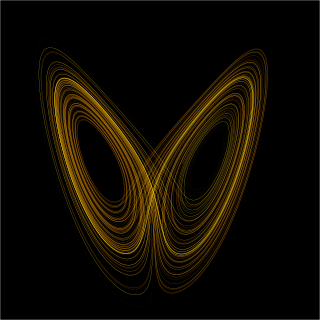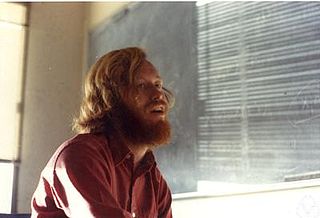
In mathematics, differential topology is the field dealing with the topological properties and smooth properties of smooth manifolds. In this sense differential topology is distinct from the closely related field of differential geometry, which concerns the geometric properties of smooth manifolds, including notions of size, distance, and rigid shape. By comparison differential topology is concerned with coarser properties, such as the number of holes in a manifold, its homotopy type, or the structure of its diffeomorphism group. Because many of these coarser properties may be captured algebraically, differential topology has strong links to algebraic topology.

In mathematics, a dynamical system is a system in which a function describes the time dependence of a point in an ambient space, such as in a parametric curve. Examples include the mathematical models that describe the swinging of a clock pendulum, the flow of water in a pipe, the random motion of particles in the air, and the number of fish each springtime in a lake. The most general definition unifies several concepts in mathematics such as ordinary differential equations and ergodic theory by allowing different choices of the space and how time is measured. Time can be measured by integers, by real or complex numbers or can be a more general algebraic object, losing the memory of its physical origin, and the space may be a manifold or simply a set, without the need of a smooth space-time structure defined on it.

Stephen Smale is an American mathematician, known for his research in topology, dynamical systems and mathematical economics. He was awarded the Fields Medal in 1966 and spent more than three decades on the mathematics faculty of the University of California, Berkeley, where he currently is Professor Emeritus, with research interests in algorithms, numerical analysis and global analysis.

Raoul Bott was a Hungarian-American mathematician known for numerous foundational contributions to geometry in its broad sense. He is best known for his Bott periodicity theorem, the Morse–Bott functions which he used in this context, and the Borel–Bott–Weil theorem.

Solomon Lefschetz was a Russian-born American mathematician who did fundamental work on algebraic topology, its applications to algebraic geometry, and the theory of non-linear ordinary differential equations.
In mathematics, particularly in differential topology, there are two Whitney embedding theorems, named after Hassler Whitney:

In differential topology, sphere eversion is the process of turning a sphere inside out in a three-dimensional space. It is possible to smoothly and continuously turn a sphere inside out in this way without cutting or tearing it or creating any crease. This is surprising, both to non-mathematicians and to those who understand regular homotopy, and can be regarded as a veridical paradox; that is something that, while being true, on first glance seems false.

In mathematics, the homotopy principle is a very general way to solve partial differential equations (PDEs), and more generally partial differential relations (PDRs). The h-principle is good for underdetermined PDEs or PDRs, such as the immersion problem, isometric immersion problem, fluid dynamics, and other areas.

Mikhael Leonidovich Gromov is a Russian-French mathematician known for his work in geometry, analysis and group theory. He is a permanent member of Institut des Hautes Études Scientifiques in France and a professor of mathematics at New York University.
In mathematics, Sard's theorem, also known as Sard's lemma or the Morse–Sard theorem, is a result in mathematical analysis that asserts that the set of critical values of a smooth function f from one Euclidean space or manifold to another is a null set, i.e., it has Lebesgue measure 0. This makes the set of critical values "small" in the sense of a generic property. The theorem is named for Anthony Morse and Arthur Sard.

In mathematics, an immersion is a differentiable function between differentiable manifolds whose differential pushforward is everywhere injective. Explicitly, f : M → N is an immersion if
In mathematics, topological dynamics is a branch of the theory of dynamical systems in which qualitative, asymptotic properties of dynamical systems are studied from the viewpoint of general topology.

Robert Edward "Rufus" Bowen was an American internationally known professor in the Department of Mathematics at the University of California, Berkeley, who specialized in dynamical systems theory. Bowen's work dealt primarily with axiom A systems, but the methods he used while exploring topological entropy, symbolic dynamics, ergodic theory, Markov partitions, and invariant measures "have application far beyond the axiom A systems for which they were invented." The Bowen Lectures at the University of California, Berkeley, are given in his honor.
In mathematics, the Schoenflies problem or Schoenflies theorem, of geometric topology is a sharpening of the Jordan curve theorem by Arthur Schoenflies. For Jordan curves in the plane it is often referred to as the Jordan–Schoenflies theorem.

Richard Sheldon Palais is an American mathematician working in differential geometry.

Michael Ira Shub is an American mathematician who has done research into dynamical systems and the complexity of real number algorithms.
J. (Jean) François Treves is an American mathematician, specializing in partial differential equations.
In mathematics, global analysis, also called analysis on manifolds, is the study of the global and topological properties of differential equations on manifolds and vector bundles. Global analysis uses techniques in infinite-dimensional manifold theory and topological spaces of mappings to classify behaviors of differential equations, particularly nonlinear differential equations. These spaces can include singularities and hence catastrophe theory is a part of global analysis. Optimization problems, such as finding geodesics on Riemannian manifolds, can be solved using differential equations, so that the calculus of variations overlaps with global analysis. Global analysis finds application in physics in the study of dynamical systems and topological quantum field theory.

Robert Luke Devaney is an American mathematician. He is the Feld Family Professor of Teaching Excellence at Boston University, and served as the president of the Mathematical Association of America from 2013 to 2015. His research involves dynamical systems and fractals.
The Colloquium Lecture of the American Mathematical Society is a special annual session of lectures.













